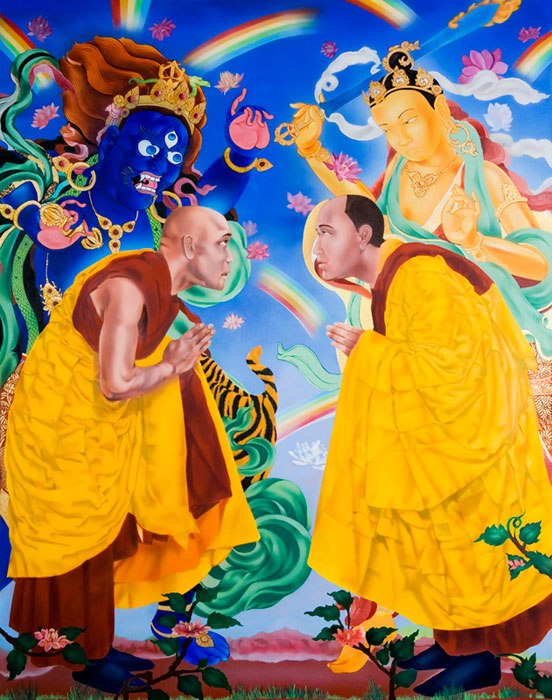Introducing The King of The Dharma to The World

March 10, 1959. Artillery shells are smashing into the Potala Palace. You need to run, and you have perhaps ten minutes to decide what to take with you, over the Himalayas, down into India.
What the family of His Holiness the Dalai Lama decided to take was a set of 15 scroll paintings called the Tsongkapa Eighty. In more than 200 intricate scenes, these paintings relate the life story of a person that we believe will become just as important to the world as Jesus or Moses or Mohammed.
The paintings did reach India, and were donated by His Holiness and his family to the Kalmyk Buddhist Temple in New Jersey, USA, since at the time this was one of the only Tibetan Buddhist centers outside of Tibet.
We’ve spent more than 15 years researching the paintings. We recovered the ancient manuscript by Jamyang Shepay Dorje (1648- 1721) which first described how the scenes should be painted, and translated it in full, comparing it with more than 50 other ancient biographies and texts (a copy with notes is shown at right). We located, in the Tsar’s library in St Petersburg, Russia, the original text of the Tsongkapa Eighty—which was written in the weeks following Je Tsongkapa’s passing from this world by his disciple Jamyang Kache (in 1419). We’ve translated and refined all the captions by comparing, with the cooperation of these institutions, later sets of the paintings held by Sera Monastery and the Istituto Lama Tzong Khapa of the FPMT.
We’ve researched and written an extensive history of how the paintings developed over the centuries, using dozens of ancient Tibetan sources, including a history of the Kalmyk Temple and how the paintings arrived there—through eyewitness accounts and interviews with people like Professor Thubten Jigme Norbu, the older brother of His Holiness. We’ve sent a team of photographers to retrace Je Tsongkapa’s steps across Tibet, and produce a pictography of places dear to his heart: Olka, where he did his long retreat; Radreng, where he had the vision to write the Lamrim Chenmo(The Great Book on the Steps of the Path), and many other holy sites. Some photos, like the famous one of the Potala at left, we’ve licensed from other photographers.
We’ve compiled a definitive list of all of Je Tsongkapa’s writings, and all the major biographies of his life, even those which have gone missing over the centuries. We’ve carefully divided out all the 200 scenes, corrected and translated the captions, and created a definitive account of each year of his life, in text and pictures.
Maps, produced with the help of the map maker for the Lord of the Rings books, portray the Master’s constant travels to teach and to learn.
An extraordinary young artist from New York, Ori Carino, has added modern interpretations of several of the scenes. These will strike you as nothing less than classics of a 21st-century Rembrandt; here, Manjushri pierces Je Rinpoche’s heart with his sword of wisdom, at a place called Gyasokpu, in the winter of 1393.
But perhaps most importantly we have divided out some 30 different roles that Je Tsongkapa played during his life: the monk, the philosopher, and the writer, certainly; but also the meditator, dancer, yoga practitioner, poet, spiritual partner and diplomat, all depicted in the paintings.
We feel that this is the most important part of the book. It is not just a record of the life of a Lama far beyond us all; rather, it is a life that was lived as an example for each of us: as the Tibetans would say, a play that was performed by Manjushri himself, posing as a human, to show each of us the lam-rim: all the steps we need to take to reach enlightenment ourselves.
This book has been a life’s work in the making. We have designed it as a coffee-table sized art book, overflowing on every page with the color of the paintings.
The book runs some 250 pages, and we have spared no expense in preparing it. We have tried to create a true classic which will remain in the world for many generations, as a record of what we believe is one of the most important lives ever lived on this planet, in its entire history. We truly foresee a time in the world where the founder of the lineage of the Dalai Lamas takes his place among the greatest spiritual leaders of all of history, and we want to introduce him to the world in a way that is worthy of the splendor of his life.
What the family of His Holiness the Dalai Lama decided to take was a set of 15 scroll paintings called the Tsongkapa Eighty. In more than 200 intricate scenes, these paintings relate the life story of a person that we believe will become just as important to the world as Jesus or Moses or Mohammed.
The paintings did reach India, and were donated by His Holiness and his family to the Kalmyk Buddhist Temple in New Jersey, USA, since at the time this was one of the only Tibetan Buddhist centers outside of Tibet.
We’ve spent more than 15 years researching the paintings. We recovered the ancient manuscript by Jamyang Shepay Dorje (1648- 1721) which first described how the scenes should be painted, and translated it in full, comparing it with more than 50 other ancient biographies and texts (a copy with notes is shown at right). We located, in the Tsar’s library in St Petersburg, Russia, the original text of the Tsongkapa Eighty—which was written in the weeks following Je Tsongkapa’s passing from this world by his disciple Jamyang Kache (in 1419). We’ve translated and refined all the captions by comparing, with the cooperation of these institutions, later sets of the paintings held by Sera Monastery and the Istituto Lama Tzong Khapa of the FPMT.
We’ve researched and written an extensive history of how the paintings developed over the centuries, using dozens of ancient Tibetan sources, including a history of the Kalmyk Temple and how the paintings arrived there—through eyewitness accounts and interviews with people like Professor Thubten Jigme Norbu, the older brother of His Holiness. We’ve sent a team of photographers to retrace Je Tsongkapa’s steps across Tibet, and produce a pictography of places dear to his heart: Olka, where he did his long retreat; Radreng, where he had the vision to write the Lamrim Chenmo(The Great Book on the Steps of the Path), and many other holy sites. Some photos, like the famous one of the Potala at left, we’ve licensed from other photographers.
We’ve compiled a definitive list of all of Je Tsongkapa’s writings, and all the major biographies of his life, even those which have gone missing over the centuries. We’ve carefully divided out all the 200 scenes, corrected and translated the captions, and created a definitive account of each year of his life, in text and pictures.
Maps, produced with the help of the map maker for the Lord of the Rings books, portray the Master’s constant travels to teach and to learn.
An extraordinary young artist from New York, Ori Carino, has added modern interpretations of several of the scenes. These will strike you as nothing less than classics of a 21st-century Rembrandt; here, Manjushri pierces Je Rinpoche’s heart with his sword of wisdom, at a place called Gyasokpu, in the winter of 1393.
But perhaps most importantly we have divided out some 30 different roles that Je Tsongkapa played during his life: the monk, the philosopher, and the writer, certainly; but also the meditator, dancer, yoga practitioner, poet, spiritual partner and diplomat, all depicted in the paintings.
We feel that this is the most important part of the book. It is not just a record of the life of a Lama far beyond us all; rather, it is a life that was lived as an example for each of us: as the Tibetans would say, a play that was performed by Manjushri himself, posing as a human, to show each of us the lam-rim: all the steps we need to take to reach enlightenment ourselves.
This book has been a life’s work in the making. We have designed it as a coffee-table sized art book, overflowing on every page with the color of the paintings.
The book runs some 250 pages, and we have spared no expense in preparing it. We have tried to create a true classic which will remain in the world for many generations, as a record of what we believe is one of the most important lives ever lived on this planet, in its entire history. We truly foresee a time in the world where the founder of the lineage of the Dalai Lamas takes his place among the greatest spiritual leaders of all of history, and we want to introduce him to the world in a way that is worthy of the splendor of his life.
